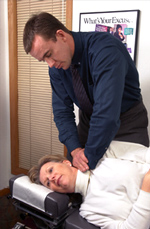Neck Pain and the Chiropractic Lifestyle
Reducing symptoms - correcting the cause.
A popular response to neck pain is taking drugs to cover up the problem (aspirin, analgesics, pain pills) or treating its symptoms (muscle relaxers, massage, hot packs).
But neck pain isn’t caused by a lack of aspirin or drugs!
The chiropractic approach to neck pain is to locate its underlying cause. This begins with a complete case history and thorough examination. Special attention is given to the structure and function of the spine, and its affect on the nervous system.
Is the proper spinal curve present? Are the nerve openings between each pair of spinal bones free and clear? Is the head balanced? Are the shoulders level? These and other considerations are used to create a plan of specific chiropractic adjustments to help improve the motion and position of spinal vertebrae.
With improved structure and function, neck pain often diminishes or totally disappears—without addictive drugs or harmful side effects!
 One study, published in the Journal of Manipulative and Physiological Therapeutics found
that patients who received chiropractic care reported significant
improvement in their neck function and a reduction in their neck pain
wheras those taking pain-killers did not.
One study, published in the Journal of Manipulative and Physiological Therapeutics found
that patients who received chiropractic care reported significant
improvement in their neck function and a reduction in their neck pain
wheras those taking pain-killers did not.A common health complaint.
Is it hard to look over your shoulder? Is there a constant pulling or throbbing pain in your neck? Do you notice a “grinding” sound as you turn your head? Contact a Doctor of Chiropractic for a thorough history and examination.
THE CHIROPRACTIC LIFESTYLE
Chiropractors are experts in the care of the bones, nerves, muscles and connective tissues that make up about 60% of your body. All of the joints in your body are part of this musculo-skeletal system and its optimal function is necessary for overall good health. Ask your Doctor of Chiropractic for more information about a care program that may include specific spinal adjustments, exercise recommendations, nutritional advice or other conservative methods of care based on your health history, age, current condition and lifestyle.
REFERENCES:
Breig, A., et al., Effect of Mechanical Stresses on the Spinal Cord in Cervical Spondylosis, Neurosurgery, 25: 45-56, 1966.
Harrison, D., D.C., Spinal Biomechanics: A Chiropractic Perspective, Journal of Clinical Chiropractic, 1992.
Kirk, R., D. C., Lawrence, D., D. C., Valvo, N., D. C., States' Manual of Spinal, Pelvic and Extravertebral Technics, 3rd edition, National College of Chiropractic, 1991.
Maynard, J., D.C., Healing Hands, 4th edition, Jonorm Publishing, 1991.
McAlpine, J., D.C., A Discussion of the Dentate Ligament Nerve Traction Mechanism, International Review of Chiropractic, October-December 1980.
Schafer, R., D.C., Faye, L., D.C., Motion Palpation and Chiropractic, 2nd edition, Motion Palpation Institute, 1990.
Strauss, J., D.C., Chiropractic Philosophy, 3rd edition, Foundation for the Advancement of Chiropractic Education, 1994.
©2002 Back Talk Systems, Inc.
(800) 937-3113 (303) 277-9990
www.backtalksystems.com
(800) 937-3113 (303) 277-9990
www.backtalksystems.com

